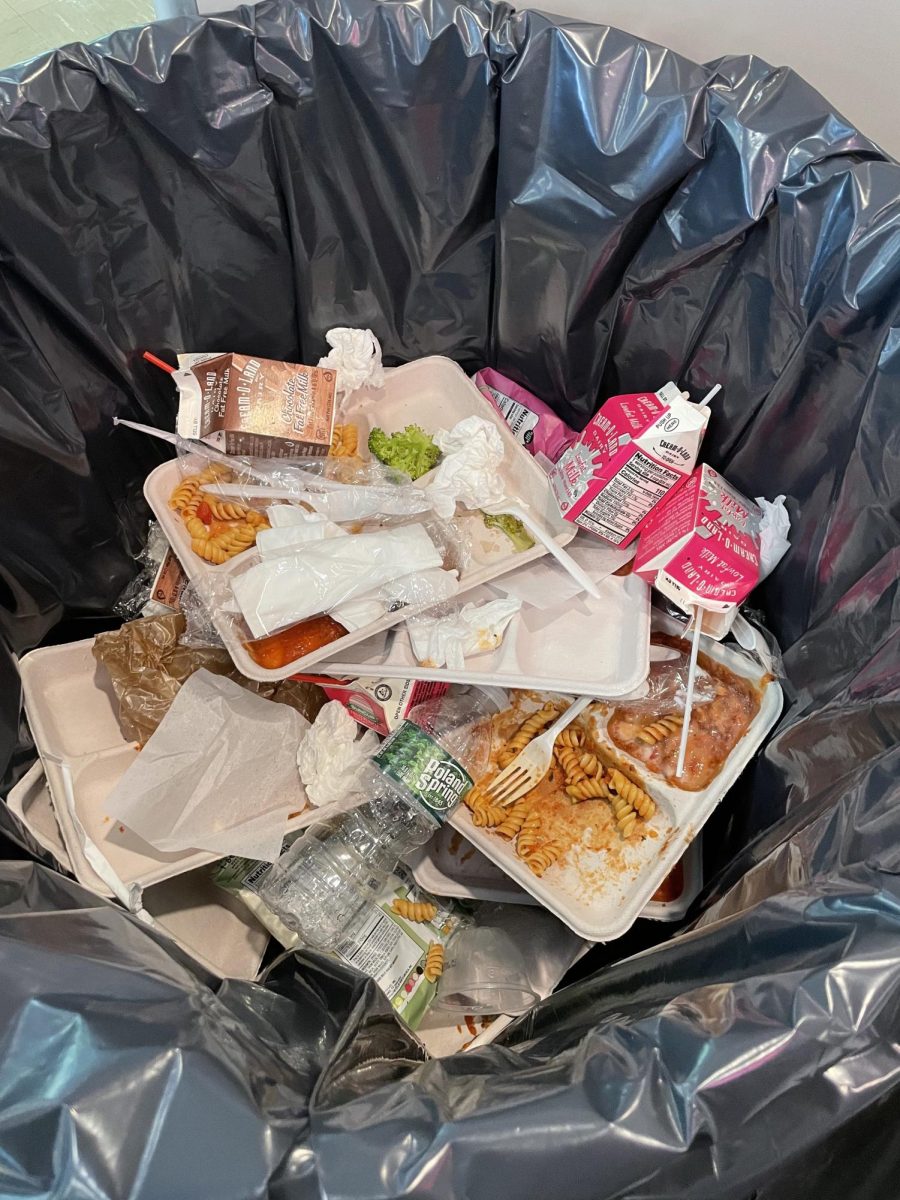The bell rings. Finally, it’s lunch. You grab a slice of pizza from the cafeteria and then dash to the library to review for a test. As you study, you manage to eat small bites, but time slips away and suddenly you hear the bell ring. You snatch your backpack and pick up the half-finished lunch tray, tossing it into the trash. You barely remember the half-eaten pizza and the unopened applesauce you threw out. Your leftovers are not forgotten, however: the trash is picked up only to end up in a landfill, condemned to create the methane emissions that will eventually annihilate our ozone layer.
Trash cans in the cafeteria fill up quickly with the contents of people’s lunch trays: unwanted plastic wrappers and wasted leftovers. The constant flow of food to the trash demonstrates the little consideration students have for their environmental impact. This habit is unsustainable; it ignores the natural resources invested in making that food and overlooks the actions that accelerate climate change. The next time they plan to throw food away, students should correct their decisions to prevent food from entering a landfill and search for a solution that would benefit the Earth.
Annually, New York produces 3.9 million tons of food waste that goes into landfills. These leftovers, starved of the nutrients from soil they need to decompose properly, produce methane: the most harmful of the three prevalent greenhouse gasses. According to the US. Environmental Protection Agency (EPA), landfills produce 15% of man-made methane emissions. Cutting down these emissions is paramount to stopping climate change and saving the planet. On average, around four bags of garbage leave the cafeteria each lunch period. At the end of the day, 20 trash bags—from both the upper and lower cafeteria—are filled.
Uneaten food also wastes water, and its transportation pollutes the air with more carbon dioxide. According to an article titled “UN World Water Development Report 2022,” 59% of groundwater in North America is dedicated to agriculture. It is illogical to waste an already highly limited resource. The air pollution produced by food transportation also heavily impacts change. According to the journal article “Global Food-Miles Account for Nearly 20% of Total Food-Systems Emissions,” the air pollution of trucks transporting crops constitutes 19% of food-related emissions—6% of all emissions.
The cafeteria recognizes the prevalence of this issue and utilizes a zero-waste policy to help reduce food waste. Thomas Lynch, the Food and Nutrition Manager of the Great Neck School Districts, explains, “We do batch cooking; a lot of schools will make everything in the morning, but we’re making it fresh [after every wave of students].” Lynch also considers the number of students who bought a specific meal when ordering new food daily. Leftover items are given for free to the students in later periods, ensuring no meal is wasted or expires. The cafeteria’s policy ensures that no food goes to waste before it reaches students’ plates. The rest is up to the students.
Students can parallel this mindset by thinking critically before choosing their meal: they can consider what meals they were able to finish in previous meals or what they could take home to finish. They can also get a smaller portion and be charged an à la carte price. As Lynch puts it, “If they only want two parts of their meal, they can share one with a friend or keep an apple to eat after school.” Also, finishing a portion before getting seconds can give students time to think if they want a second lunch.
Despite the negative attitude attached to cafeteria food, the cafeteria staff works hard to adjust the lunch menu to students’ taste. “Every now and then, you’ll see something new. I’ll try it and if it goes well, then I just rotate it into the menu. Everything [on the menu] is what [the students] like,” says Lynch. The cafeteria staff repeats well-liked meals and omits unpopular ones. The changes in the school lunch are astronomical: from synthetic chicken nuggets to perfectly-fried chicken drumsticks, the cafeteria staff cares about what students eat.
Some may argue for the importance of lunch as a catch-up period, putting meals second to finishing homework. This dilemma means that students frequently do not have time to finish their lunches and instead throw them out. AREA-C’s (the Animal Rescue and Environmental Awareness Club) new composting project provides a helpful and environmentally beneficial solution. Ann Yao, co-president of AREA-C, says, “We tried implementing a composting initiative in the past. While at the time there wasn’t enough support to make that happen, now, knowing that it is a want people have, we will be trying it again this year.” Composting allows students to recycle biodegradable substances back into the earth to create fertile soil. As reported by an anonymous custodian, most meals that end up in the trash typically consist of fruits and vegetables—essential components of composts. Students who contribute to the composting project would be finding a useful place for their unfinished food, limiting the amount of food that goes into landfills.
Food waste is a prevalent issue often disregarded for other concerns such as global warming. However, it is an issue closer to home, more solvable, and contributes to climate change as well. “There’s never a shortage of people who care and people who want to care and people who want change,” Yao says. While solutions for reducing fossil fuel emissions are more unattainable for students to achieve, simply finishing all the food on your plate can limit the waste of water and production of greenhouse gasses. The first step in fixing food waste is being aware—the next, your action.










